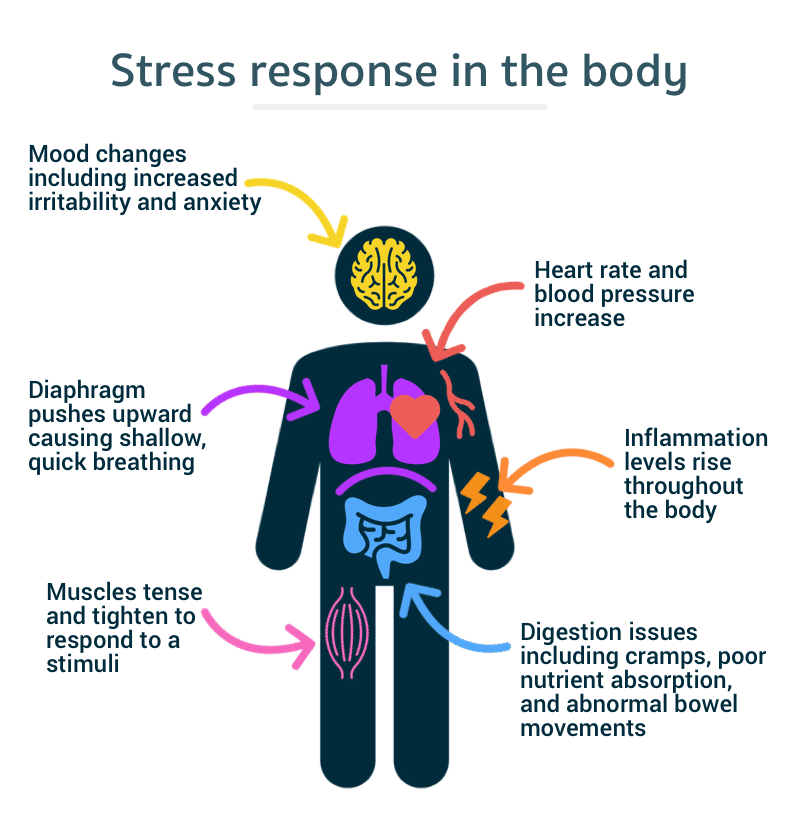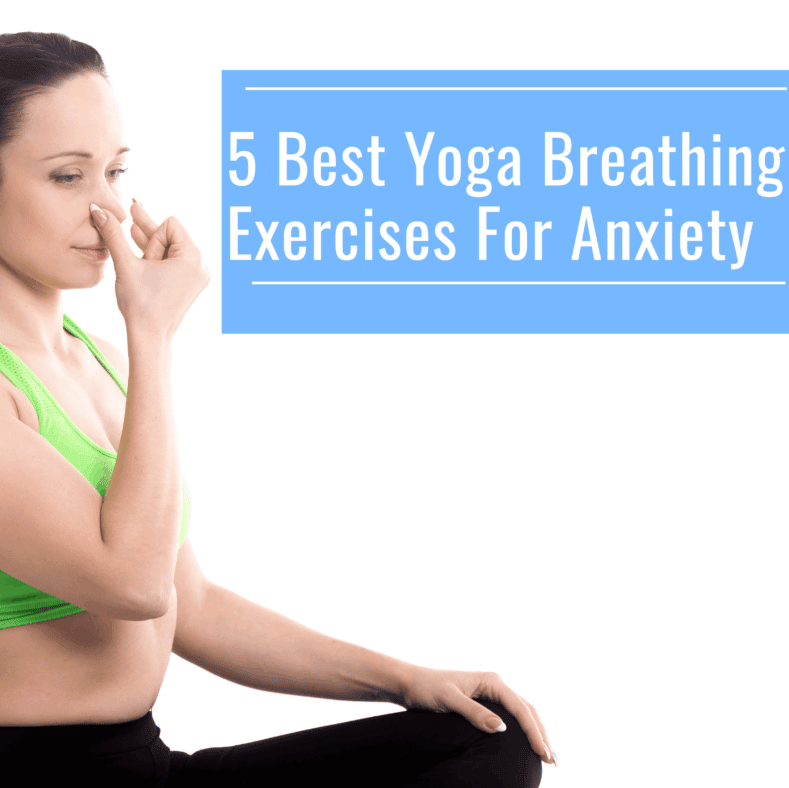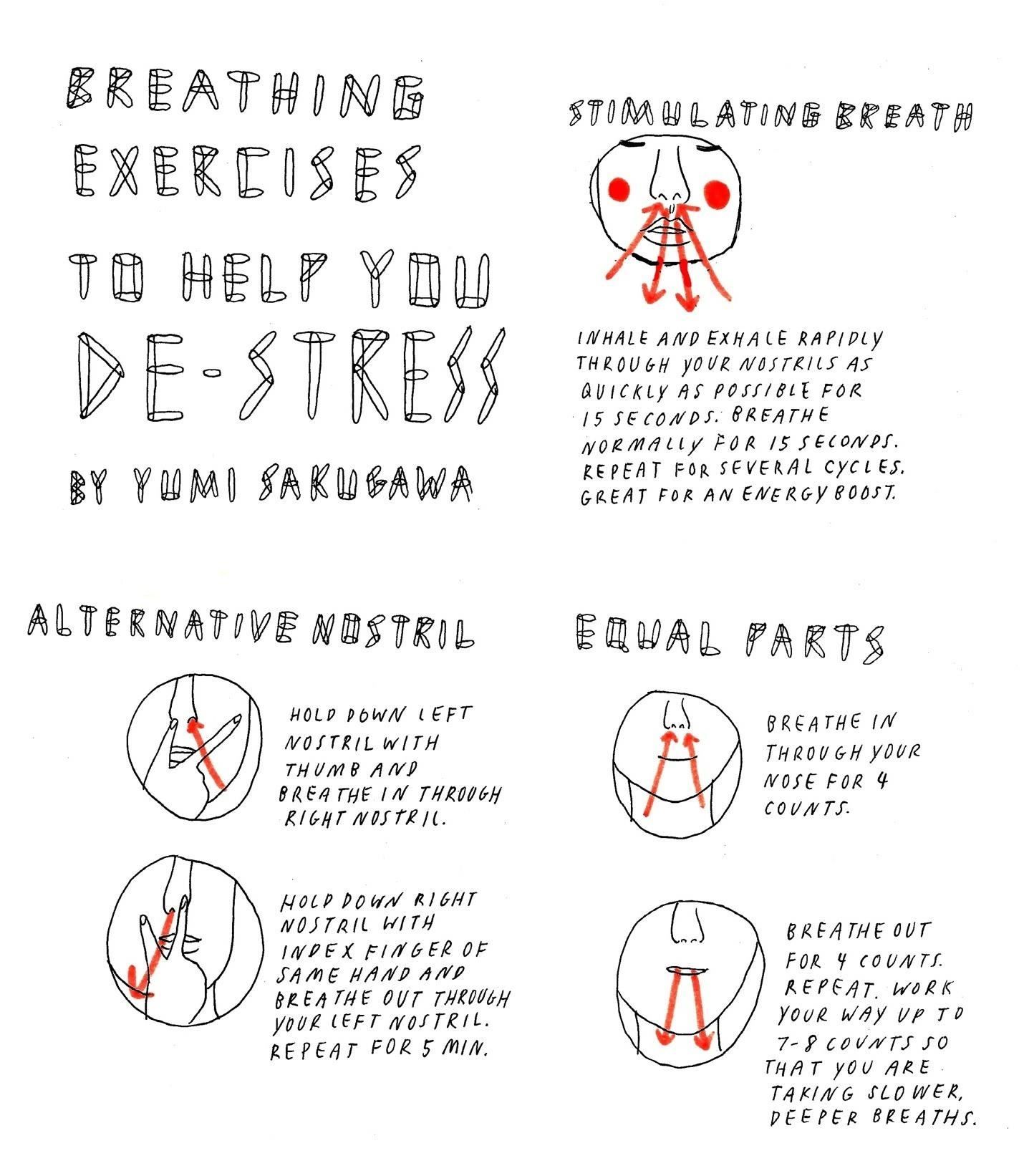Breathing Techniques For Anxiety Control
Anxiety is one of the most common mental health issues people face in the 21st Century. Unfortunately, due to a hectic, fast-paced, and busy lifestyle, many of us feel severely overwhelmed by the exorbitant number of tasks making their way onto our lengthy To-Do lists. Similarly, societal norms and socially constructed milestones set unrealistic expectations for us to achieve !
This article will primarily focus on the management of anxiety via breathing techniques, but will also review a variety of different treatments/relaxation exercises that may also calm the symptoms of an anxiety attack. Although this content was made to cause less stress and to help you overcome the anxiety that is negatively impacting your life, please do not substitute the content supplied for medical advice. Please seek additional health information/ support if needed, and always involve your trusted doctor or licensed mental health professional in new techniques or treatments before you try them.
The Benefits Of Breathing Exercises
There are many. Think of a scenario that causes people stress, and theres probably a study that shows breathing techniques can help lower stress in that situation.
For example, research has found that breathing exercises can reduce the stress that many people feel while driving or just before a surgical operation . They can also help people calm down while speaking in public .
Deep breathing can help reduce job-related emotional exhaustion and other symptoms of burnout . Theres even some evidence that breathing techniques can enhance reading comprehension .
Drilling down on anxiety, research among people with anxiety disorders suggests breathing exercises may be an effective first-line therapy for those conditions. Breathing coupled with other practices, such as meditation, may be even more effective than anti-anxiety drugs .
Stress and anxiety benefits aside, breathing exercises are an established therapy for some lung diseases and related medical conditions. For example, breathing exercises can help people with asthma or COPD . Some experts have also recommended breathing exercises as an effective way to help people recover from COVID-19 .
Breathing techniques may also help lower your heart rate and blood pressure and improve several other markers of heart health . More work has found that they can help reduce pain and prevent insomnia . The list goes on and on.
Breathing Exercise #: Alternate
Alternate-nostril breathing is the act of blocking off one nostril at a time, and breathing through the other. The intention is to breathe through alternate nostrils in a regular pattern. This is best practised while sitting down in order to maintain your posture.
If you happen to feel light-headed after practising this, take a break from it. Release both nostrils and breathe normally.
You May Like: What Physical Symptoms Can Anxiety Cause
Best Breathing Exercises For Anxiety
If you find yourself feeling nervous, unsettled, or even downright panicky about the state of the world these days, youre far from alone.
In response to current events, people are pursuing strategies to support their mental health in record numbers worldwide.
We know that physical exercise is an excellent way to reduce anxiety, but its not always possible to break into your favorite routine when the jitters hit.
Thankfully, you can use these simple, expert-recommended breathing exercises to help recover your inner calm anytime, anywhere.
Six Breaths Per Minute Training

This simple breathing technique is precisely what it sounds like. Your goal is to take slow, controlled, even breaths at a rate of six per minute. That works out to one full breath, in and out, every ten seconds.
Research has found that doing this for just ten minutes can improve several measures of heart-rate variability . Mood and mental health disorders impact HRV. Targeting it with breathing exercises may help people with panic disorder and other stress- or anxiety-related conditions .
You May Like: What Is The Best Ssri For Anxiety
On The Internet Therapy Providers: Just How They Can Assist You Gain Mental Health And Wellbeing
Online therapy services are becoming significantly popular in the past couple of years. This is because people are significantly coming to be much more comfortable with sharing their ideas and also feelings online.
The advantages of online therapy include:.
- Enhanced confidentiality
- Even more ease of access to psychological health and wellness professionals.
- Lowered preconception
Online Therapy Is An Excellent Alternative For Everybody To Remain On Board
Online therapy is great for everyone to stay on board, despite their place. It gets rid of the barrier of geographical distance and also gives individuals the opportunity to obtain help without taking time off work. There are many benefits to on the internet therapy, including anonymity, convenience, and ease of access.
Online therapy, counseling, as well as affordable therapy are how this new pattern can be utilized to help people cope with everyday stress. Best Breathing Techniques For Anxiety
People that are too ashamed to look for therapy in individual might discover it valuable to see a therapist online. Online therapy is less intimidating as well as can provide the same benefits as typical therapy sessions.
Online therapy is rapidly ending up being a preferred option for lots of people. Due to the stigma bordering psychological wellness, several individuals are terrified of going to a specialist in individual and instead turn to on the internet therapy services for assistance with their issues.
Read Also: Why Does My Dog Have Anxiety
Can Breathing Exercises Cure Anxiety
Breathing exercises can treat mild anxiety by signaling the body to calm down. They are an important part of integrative medicine, backed by a growing pile of clinical research. There are many breathing techniques you can try, but studies indicate deep, slow, and rhythmic breathing is the most effective to reduce anxiety.
Breathing Exercises For Stress
This calming breathing technique for stress, anxiety and panic takes just a few minutes and can be done anywhere.
You will get the most benefit if you do it regularly, as part of your daily routine.
You can do it standing up, sitting in a chair that supports your back, or lying on a bed or yoga mat on the floor.
Make yourself as comfortable as you can. If you can, loosen any clothes that restrict your breathing.
If you’re lying down, place your arms a little bit away from your sides, with the palms up. Let your legs be straight, or bend your knees so your feet are flat on the floor.
If you’re sitting, place your arms on the chair arms.
If you’re sitting or standing, place both feet flat on the ground. Whatever position you’re in, place your feet roughly hip-width apart.
- Let your breath flow as deep down into your belly as is comfortable, without forcing it.
- Try breathing in through your nose and out through your mouth.
- Breathe in gently and regularly. Some people find it helpful to count steadily from 1 to 5. You may not be able to reach 5 at first.
- Then let it flow out gently, counting from 1 to 5 again, if you find this helpful.
- Keep doing this for at least 5 minutes.
Also Check: How To Deal With High Functioning Anxiety
Choose The Best Breathing Exercises For Your Anxiety
Whilst some of these techniques are best used in specific circumstances , each one ultimately achieves the same result Getting us out of those fast, shallow breaths that cause our anxiety symptoms and back into the deep, relaxing breaths that leave us feeling calm.
To determine which one is best for you, you might want to take some time to practice each one and decide for yourself which is the most effective in alleviating your anxiety.
The Benefits Of Deep Breathing Exercises For Anxiety
Studies show that deep breathing techniques can positively affect your heart rate, respiratory rate and central nervous system. What seems like a simple breathing exercise can in fact help enhance cerebral and psychological flexibility, allowing you increased emotional control situationally, so you can feel better.
It is unclear exactly how breathing techniques work yet some hypotheses suggest they may cause your body to relax, and others suggest that they signal to your body that it can relax. The key is that regardless of the reasoning, breathing exercises for anxiety can be effective.
This is incredibly beneficial to people who suffer from chronic anxiety, anxiety disorders and panic disorder, which can all lead to situations during which your anxiety essentially overwhelms you.
Panic attacks can cause a variety of symptoms to suddenly appear, from intense fear and heart palpitations, to feelings of doom and lack of control. Panic attacks can cause shortness of breath, too.
And since the National Institute of Mental Health notes that people who do suffer from panic attacks often worry about future attacks, one of the best ways to prepare is to have a plan, which can involve breathing exercises.
Don’t Miss: How To Date Someone With Anxiety
Breathing Sends A Message
When you breathe deeply, you do more than inhale and exhale air. You send a message to your brain to relax. Your brain then directs the message to your body.
Yogic breathing can help you to achieve balance in both the body and mind. Mind-body practices are increasingly used when treating post-traumatic stress disorder . They have been linked to positive effects on stress-induced illness. To experiment, follow these steps:
Many of the breathing techniques known to reduce anxiety come from, or are similar to, practices you may know from yoga. They are designed to help you keep a healthy balance in both body and mind. They emphasize being deliberate and mindful about your breathing so you can reduce stress and anxiety, and feel calm and in control.
Can Stress And Anxiety Cause Shortness Of Breath

Stress and anxiety can absolutely cause shortness of breath. This is usually due to hyperventilation, although it can also be caused by other irregular breathing patterns.
Hyperventilation is what occurs when we over-breathe. This type of rapid breathing causes the activation of the sympathetic nervous system, responsible for our fight or flight instincts. This causes our heart to pump blood to our extremities and our anxiety levels to skyrocket.
To counteract the anxiety spiral this can cause, its important that we get our breathing under control. This is one of the most important steps to stopping a panic attack or anxiety.
Often called breathwork, there are many breathing techniques and exercises for stress and anxiety. The goal with any of these is to slow and normalize our breathing pattern.
One of the most effective ways to do this is with the 478 breathing method.
Read Also: When Does Separation Anxiety Start In Babies
Use A Stuffed Animal To Practice Deep Breathing
Have your child lay down on their back and put a stuffed animal on their belly. Have them breathe in and move the stuffed animal up, then breathe out and bring the stuffed animal back down. This helps teach kids to use their belly to take big deep breaths. Another alternative is to use a weighted stuffed animal.
Breathing Exercise #: Diaphragmatic Breathing
This is also known as belly breathing. This exercise is best done when you are feeling relaxed. This can be practised for 5 to 10 minutes, 3 to 4 times per day. Here are the steps:
To increase the difficulty, you may place a book on the abdomen. Once you have gotten the knack for doing this breathing technique while lying down, you may attempt it while seated in a chair or while performing daily activities.
Read Also: How To Get Over Work Anxiety
List Of Breathing Exercises
This is a list of breathing exercises that you may try that would not take too much time in your day. It is about taking the time to be intentional with your breathing. These exercises are used to reduce stress or improve lung function.
The most benefits are found if you do these regularly as a part of your daily routine. Most can be done standing up, sitting in a chair, or lying down.
Breathe Using Your Stomach
The second breathing technique includes a lot of work for your stomach. First, you need to lie down and place one hand on your stomach. Place the other hand on your chest. Then inhale deeply through your nose, and you will feel your stomach rise. Breathe out through your mouth. When exhaling, try to contract your stomach muscles to force the air out.
Read Also: Is Anxiety All In Your Head
Best Breathing Techniques For Anxiety
As a BetterHelp affiliate, we may receive compensation from BetterHelp if you purchase products or services through the links provided
In this blog, were going to look at over fifteen of the best breathing techniques for anxiety. Readers will first understand how breathing can help you control your anxiety. Then, we will take a closer look at these breathing techniques.
Breathing Exercise #: Mindful Breathing
This technique requires you to focus completely on breathing without needing to change the natural rhythm. This method could be useful in helping anxiousness, stress, sleep issues, or high blood pressure. Some may find this as a form of meditation.
To perform mindful breathing, be sure to meet these factors:
- Find a peaceful place without distractions
- Be comfortable in your body posture, be it sitting or lying down
- Focus solely on breathing
- Allow thoughts to pass through the mind without feeling strongly about them
Don’t Miss: What Can You Give A Child For Anxiety
Can Pranayama Breathing Exercises Help With Anxiety
Breathing exercises are a natural, accessible, and effective way to reduce anxiety. Many people suffering from mental health issues have turned to yoga for relief, particularly meditation and pranayama.
Research indicates pranayama can significantly reduce anxiety . Studies have also linked pranayama with focus and processing emotions. So, there is undoubtedly anecdotal and empirical evidence to support the claim.
In this post, we put forth five yoga breathing techniques to anchor the mind. We have chosen pranayama anyone can do and laid them out in an order of difficulty.
You can attempt the first three without any experience with yoga. The other two are more nuanced, but not inaccessible if you put in a little effort. We have detailed guides for these breathing techniques that we’ll link along the way.
Here are 5 breathing exercises for anxiety and stress reduction.
Other Ways To Reduce Anxiety Quickly

Breathing exercises are just one way of managing anxiety.
People can also try things such as slowly counting to 10 or imagining a calming scene, such as a meadow or a beach.
Psychiatric medications can also help.
According to the Anxiety and Depression Association of America, people can help themselves by:
- accepting that there are some things they cannot control
- doing their best rather than aiming for perfection
- learning what triggers their anxiety
- limiting their caffeine and alcohol intake
- trying only to eat well-balanced meals
- trying to get plenty of sleep
- getting some exercise every day
You May Like: How To Use Essential Oils For Anxiety
What Is Diaphragmatic Breathing
Riehl: Diaphragmatic breathing can be described as deep breathing that is applied to help alleviate both physical and emotional symptoms.
When someone is engaging in this type of breathing, they contract their diaphragm by exercising a deeper form of inhaling that extends into their belly. Typically, individuals breathe in their chests, which many refer to as shallow breathing that can actually exacerbate feelings of anxiety and worry.
Through this deeper exchange of incoming oxygen and outgoing carbon dioxide, ones body, as well as their nerves, are calmed down.
Like Podcasts? Add the Michigan Medicine News Break on iTunes or anywhere you listen to podcasts.
Super Simple Meditation Breathing
Breathing techniques don’t need to be complicated. This very simple breathing exercise is one of the most effective anxiety relief techniques. The only instruction is to breathe out slowly. The key is to focus on your out-breath and ignore your in-breath. Your in-breath will naturally lengthen when your out-breath is longer. Therefore, you don’t need to actively focus on your in-breath at all.
Try to make your breath out slow, steady, and gentle. Some people find it useful to imagine they’re blowing up a balloon, slowly and steadily and with the absolute least amount of force. Breathe out until the last drop of breath is released.
While you’re slowly breathing, you can also scan your body for anywhere you’re holding tension. Typical places are your lips, jaw, and shoulders. With each slow out-breath, allow the tension you’re holding to flow out, and relaxation to flow in.
Also Check: How To Love Someone With Anxiety And Depression